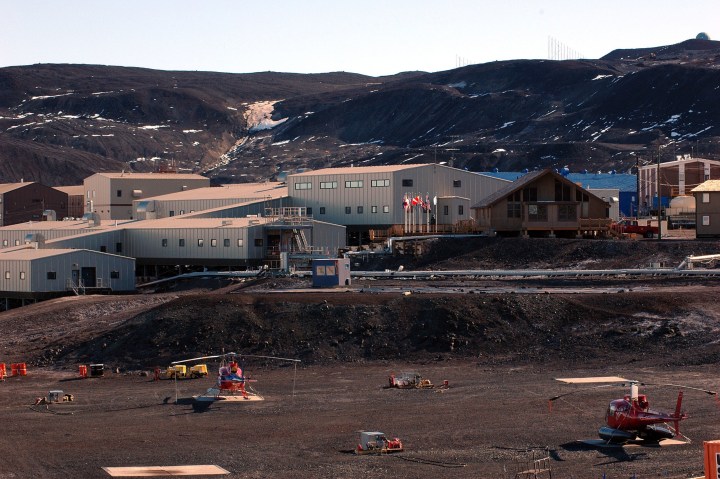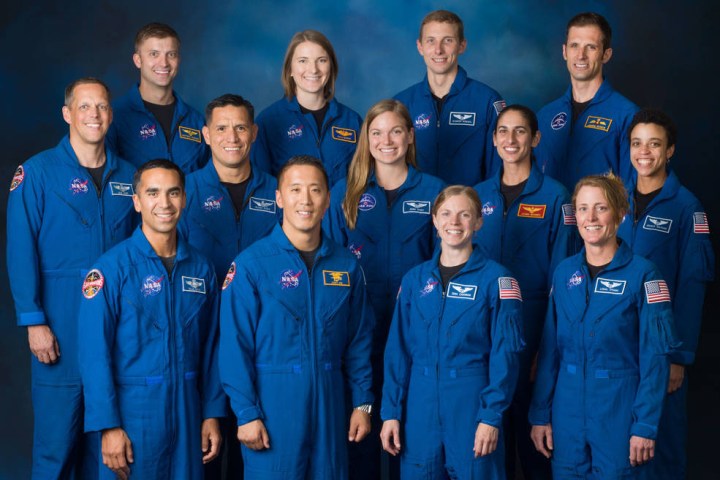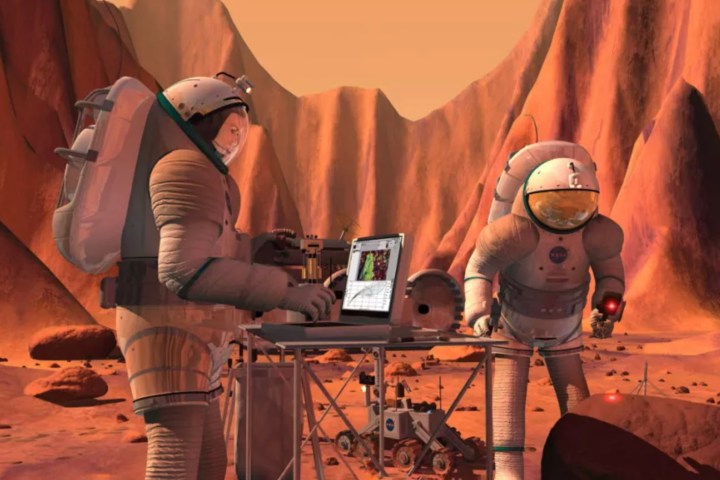
Astropsychology: How to Stay Sane on Mars
A lot can go wrong in space — that we know for sure. We’ve seen it: Rockets explode on the launch pad. Communications cut out seemingly at random. Pressure valves fail. Oxygen runs out.
Space agencies, however, anticipate all these technical problems in advance. So as we plan to go to Mars and potentially settle there as a species, the most unpredictable element we have to prepare for is not the spacecraft we send but the humans aboard it.
 NASA
NASA
Astronauts face a number of hazards when they choose to be strapped to a rocket and shot off the face of the Earth: Radiation, lack of gravity, and the possibility of encountering and inhabiting an inhospitable environment. But over the past two decades, researchers have narrowed their attention on how isolation and confinement can affect an astronaut’s mental health and psychological performance.
“There are different kinds of isolation,” said Shannon Rupert, director at the Mars Desert Research Station, “some you can train for and some you can’t.”
Unlike previous expeditions to the moon and to the International Space Station, space crews will face one-of-a-kind challenges during the journey to Mars.
Those aboard the ISS regularly speak with their families and have supplies sent to them every few weeks. That won’t be possible on Mars since there will be a 20-minute communication delay. And while it takes three days to get to the moon, it will take eight months to even land on Mars — this means astronauts traveling there will have to mentally prepare for being away from Earth for up to three years.
That’s a long time.
While there have been dozens of isolation experiments performed in hopes of determining what psychological challenges future Mars settlers might face, experts told Digital Trends that preparation is only the half of it.
This article is part of Life on Mars, a 10-part series that explores the cutting-edge science and technology that will allow humans to occupy Mars
A highly selective process
Not everyone can be an astronaut. And not everyone can go to Mars. NASA, the European Space Agency (ESA), and even private companies like SpaceX and Blue Origin have rigorous requirements for those who want to be sent to Mars. There are more than 7.8 billion people who live on Earth, and only 565 of those people have ever been to space.
“You have to find people who have that innate sense of being OK in that sort of extreme isolation.”
Astronauts have to be physically fit and active; highly skilled in either math, science, or engineering; have 1,000 hours or more of piloting experience or similar professional experience; and have the mental stamina to perform at their peak in high-pressure situations for long durations under rigorous surveillance. Decision-making and productivity are also closely monitored for selection. This means being on top of your game 24 hours a day.
“As you can imagine, it’s hard to find highly capable, highly-accomplished people who are available to come and be an astronaut,” said Alexandra Whitmire, a deputy element scientist for NASA’s Human Research Program.
Whitmire said NASA looks at those who already have experience doing long-term expeditions, whether with the military or with other analog study programs in places like Antarctica.
 Antarctica Analog Studies/NASA
Antarctica Analog Studies/NASA
“We recognize in a future mission to Mars, we anticipate the crew is going to be a highly resilient, high-performing crew,” said Whitmire. “But there is also a definite acknowledgement that the Mars missions are going to be unprecedented and isolating.”
Rupert, who runs the Mars Society’s research facility located in the Utah desert, which hosts eight-month-long field studies, believes that not only do future astronauts have to have incredible professional skills, but they must also have interpersonal skills in order to survive — and stay sane — while working and living with cabin mates.
“You have to find people who have that innate sense of being OK in that sort of extreme isolation,” she said. “The ones who aren’t afraid to take chances, but they’re not risk-takers, they’re okay with being bored, so they’re not high strung and have the ability to communicate. So you have to put all those qualities together in one person, and even after you’ve done all that analysis, you’ll never know if it’s going to work.”
Simulations test more than knowledge
When the U.S. sent Neil Armstrong, Michael Collins, and Edwin “Buzz” Aldrin to the moon in 1969, whether or not the three had chemistry was not a priority.
Today, however, it is.
How space crews get along can have an impact on whether or not their mission is successful.
The Mars 160 Mission – A Close-Up Look at Simulated Living on Mars – video
NASA spends years selecting who it will send on space expeditions. And even after crew selection is finalized, candidates are closely watched for years after to see how well they can work together and if they have complementary traits.
Many of the simulated missions NASA performs within its Human Research Program monitor participants for six weeks at a time. The crew is tested in a way that simulates a space flight mission and are given a heavy workload, according to Whitmire. Researchers then control external variables, like manipulating the communication delay, assigning daily tasks, inducing sleep deprivation, and sometimes reducing the “habitable volume” and eliminating some of the participants’ privacy.
This is done because researchers want to adequately pinpoint confinement risks and potential physiological stressors. At the end, researchers evaluate the crew’s logs, journals, and surveys.
 Bill Stafford/NASA
Bill Stafford/NASA
But according to Sheryl Bishop, a social psychologist who has conducted behavioral research in extreme environments for more than 25 years, even those communications are “highly filtered.”
“We don’t get close to the real emotions of the things that are going on in a person’s head — they keep that kind of information private,” said Bishop. “If you are one of those guys selected for a program like this, you want to be seen as competent and supremely fit for the job. Can you do that if you are also going to be like, ‘You know I really get down sometimes.’ No, no one is going to say that.”
The most common emotions space crews express after simulations and Mars analogs (missions that closely replicate the conditions of the red planet in terms of terrain and duration) are depression, anxiety, isolation, and relief according to Rupert. The relief reflects the fact that participants are often glad to be out of such a small, tight space. Whitmire added that NASA has seen “dampening of positivity” in its participants over a period of time during analogs, too, but no serious cases of depression.
Crew conflict also comes up in simulations.
“There are a lot of big things to worry about, but then you also have to deal with the little things, the little irritations, like somebody who clips their fingernails at the table — the weird stuff,” Rupert said. “You have to be able to tolerate a lot and leave a lot of those feelings behind.”
 NASA/JSC
NASA/JSC
Rupert has also found that if one person is having a hard time, that feeling is almost certainly going to leak out and affect the rest of the crew. If one person is being a downer and not asking for help, or is hiding that they are struggling at all, it could make others not want to be around them, further isolating them in an already severely isolated environment.
Researchers like Rupert, Bishop, and Whitmire have all found that extended bouts of isolation and confinement can have adverse health outcomes, like high blood pressure and insomnia, as well as the capability to alter the outcome of a mission.
So how does someone headed to Mars, with no possibility of simply turning around, cope?
Coping doesn’t necessarily mean meditation
Anyone crammed into a small space with other people for an extended period of time is going to go through a wide range of emotions. Dealing with those emotions is different for everybody.
Astronauts routinely have access to psychologists through mission control. No one is ever truly isolated during space missions because there is a buddy system, and crews can have up to nine people. But being open and honest about the feeling of isolation is the first step an astronaut can take to get the care they need on a journey to Mars.
To mitigate isolation, researchers have found routine, exercise, and meditation to be powerful tools. Space crews are encouraged to have game nights, watch movies together, and eat together. Another important factor to help lessen the feeling of stress is emphasizing downtime, taking a day off, and actually taking the day off.
Inside Look at the Mars Simulation Project in Utah
NASA is also working with research that suggests greenery and plant life is important to one’s mental health. Taking care of plants can be a great sensory outlet for astronauts, said Whitmire, but what if a plant dies and can’t be revived? That has the ability to take a big toll, psychologically.
Rupert said one of the most beneficial coping mechanisms a crew can have collectively is the feeling of responsibility for one another.
“We’re taught to be independent and that we don’t need help, but when you find yourself on a long-term mission with just a few other people, you have to realize you are responsible for them, too,” she said. “So you also have the responsibility to ask for help. Almost all of the accidents that occur at the station are the result of someone not being honest.”
But even if the first-ever crew members sent to Mars are honest about their feelings, meditate regularly, exercise, water their plants, and have meals together, something can still go awry.
“The Mars mission will be the most isolating experience in human history,” said Bishop. “We will be completely separated from all of our species, and we will be stuck. We can’t open the door and walk out. It doesn’t matter how desperate you get. You can’t go. And that’s what we have to be training our crews for, so that it never gets to that point.”
This article is part of Life on Mars, a 10-part series that explores the cutting-edge science and technology that will allow humans to occupy Mars


